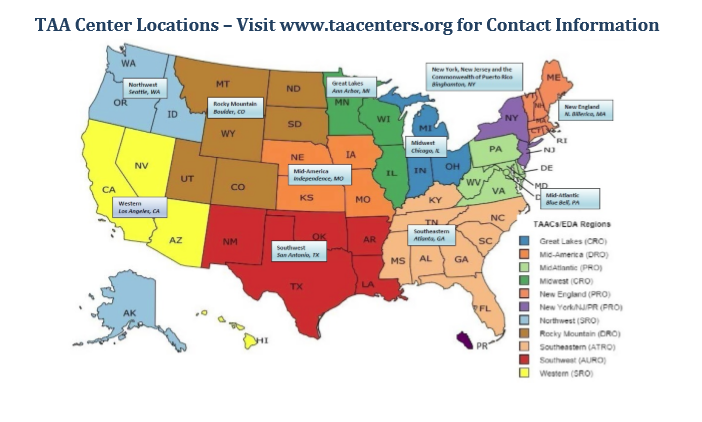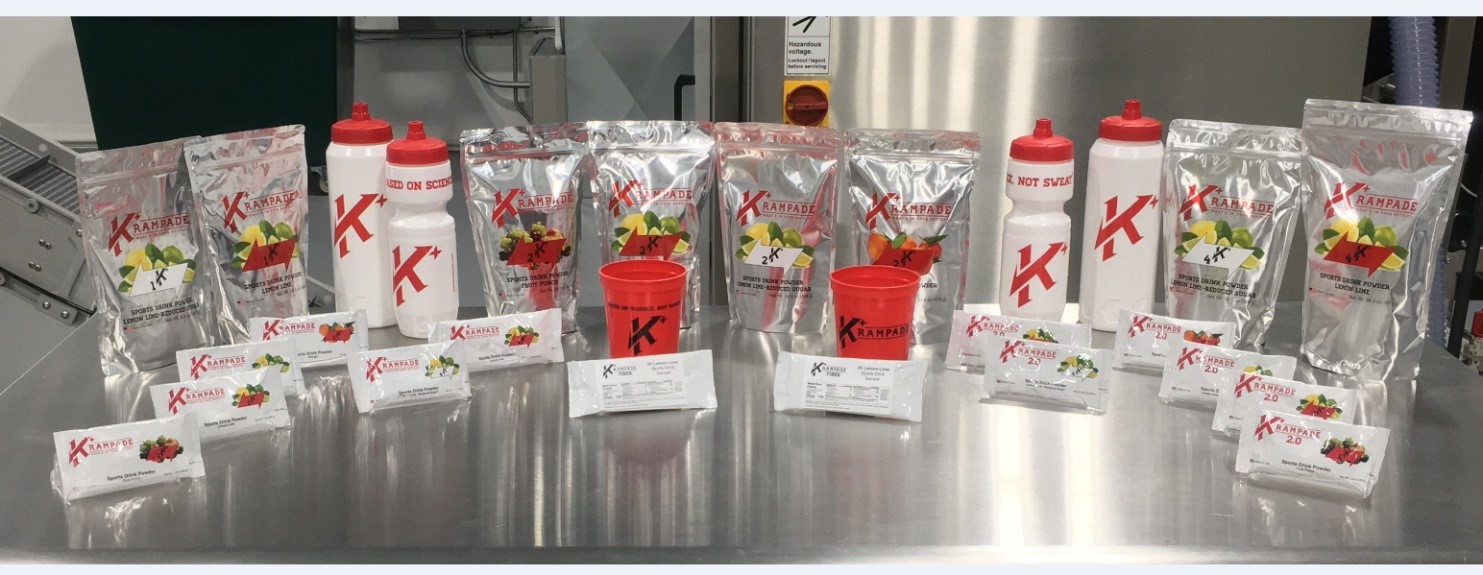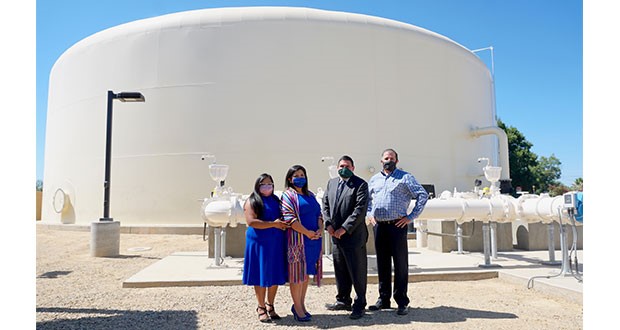
August 2020
In This Issue
Spotlight: EDA’s Trade Adjustment Assistance Centers Spur Growth and Global Competition for American Businesses TAAC Center Locations
The Trade Adjustment Assistance for Firms (TAAF) program was established by Congress under the Trade Expansion Act of 1962. Through the TAAF program, the U.S. Department of Commerce’s Economic Development Administration funds a national network of 11 non-profit and university-affiliated Trade Adjustment Assistance Centers (TAACs) to strengthen the competitiveness of American companies that have lost domestic sales and employment because of increased imports of similar goods and services. In general, the program provides cost-sharing technical assistance to eligible import-impacted American firms. Firms receive technical assistance to create and implement targeted business recovery plans. When a Wyoming manufacturer of laboratory equipment entered the TAAF program with Rocky Mountain Trade Adjustment Assistance Center (RMTAAC) in 2016, the company had experienced a 33 percent drop in sales due to Asian import competition. With TAAF technical assistance, projects were undertaken to improve the firm’s production efficiency, enhance its enterprise resource planning system, and better promote the firm’s products and capabilities. Success Story: Krampade Sports Drink Leverages Revolving Loan Fund to Secure Public/Private Investment for Business Growth Krampade Products
EDA makes Economic Adjustment Assistance (EAA) grant awards to establish Revolving Loan Funds (RLFs) that make loans to businesses that cannot otherwise obtain traditional bank financing. These loans provide access to capital as gap financing that enables small businesses to grow and lead to new employment opportunities with competitive wages and benefits. The economic development priorities of each RLF are defined in a specific RLF Plan that guides the lending strategy within its defined lending area. Most RLFs make general business loans focused on creating and retaining jobs while leveraging other sources of capital. Some RLFs focus lending to certain sectors or industries. Krampade LLC, a borrower of RLF recipient Grand Forks Growth Fund, is a North Dakota-based sports drink company that was founded in 2015. Krampade is a powder that mixes into water for use in mitigating acute and chronic cramping. Many of the company’s major users are elite athletes, and several of its products also target the average consumer for treating issues ranging from dehydration-related headaches to heartburn. Krampade was seeking financing for the purchase of equipment needed to get its production facility up and running in Grand Forks, North Dakota, but was unable to get the funds necessary through traditional financing. Grand Forks Growth Fund’s loan of $160,000 was critical in moving the project forward and enabled the company to grow. Since the Growth Fund had the EDA RLF resources to buy into the project, it was also able to leverage $120,000 from the North Dakota Development Fund and also a combined loan from Gate City Bank and the Bank of North Dakota to effectively share in filling the funding gap. This leveraging power is perhaps the EDA RLF’s greatest benefit for this project, as it made it possible to spread the risk and expand buy-in to the company’s success. Highlight: Improvement in Local Drinking Water Enables Businesses and Communities to Prosper in Sanger, California City of Sanger Water Tank Ribbon-Cutting
On July 8, the city of Sanger, California hosted a ribbon cutting to celebrate the new operation of the city’s new water system and holding tank. The 750,000-gallon tank, nitrate blending station, and booster pump is a joint project with the California Division of Drinking Water and a $1.2 million EDA investment to help the city serve its residents with clean water. The new tank was built to improve water pressure and water quality year-round. The project, which was completed in a year, also secured an additional $4 million in state funding. Due to low water pressure and a lack of storage capacity, Sanger was unable to keep up with current business and residential water demands, which resulted in low water pressure and a need for additional capacity for the city and region. |
|
|
|||
U.S. Department of Commerce Awards $1 Million for R2 Network Challenge for Innovation in Disaster Response and Resiliency Technology On July 1, EDA, along with the National Institute of Standards and Technology (NIST) and the First Responder Network Authority (FirstNet Authority), announced the awardee of the Accelerate R2 Network (R2 Network) Challenge. The R2 Network Challenge is an interagency program that connects stakeholders in the response and resilience (R2) industries, accelerating the speed at which startups and other organizations can bring innovations to the public safety market, create new businesses and jobs, and support community resilience. Read about the agencies selected in the official DOC press release. EDA CARES Act Job Opportunities Available: Work on the Front Lines to Help American Economy Recover from COVID-19 EDA is supporting the whole-of-America effort to help our nation’s communities respond to and recover from COVID-19. If you or someone you know is interested in joining our team to support our CARES Act Recovery Assistance work, visit https://www.eda.gov/careers/ for up-to-date information on our latest openings. Summertime with the CEDS The NADO Research Foundation is pleased to host “Summertime with the CEDS,” a mix of free online content ranging from webinars to workshops to support your CEDS planning and implementation efforts. Contact Brett Schwartz at bschwartz@nado.org for more information.
EDA in the News!U.S. Department of Commerce Invests $1.2 Million in CARES Act Funding to Help Small Businesses in Arizona Grassley Praises U.S. Department of Commerce Investing $13.1 Million in CARES Act Funding to Help Small Businesses Across Iowa Respond to Coronavirus Feds invest $1.9M for infrastructure in Fresno County town Feed the Hunger Foundation to receive $649K in CARES Act funding to help Hawaii small businesses Sen. Moran announces grants to support Kansas businesses impacted by COVID-19 New Economic Development Website Promotes Regional Partnership Department of Commerce invests in CARES Act funding to boost economic development programs critical to helping Nez Perce Tribe respond to Coronavirus U.S. Department of Commerce Invests $400,000 in CARES Act Funding to Boost Economic Development Programs Critical to Helping 7-County Southeast Idaho Region Respond to Coronavirus Coronavirus In Wisconsin: University of Wisconsin-Stout Receives $300K In CARES Act Funding BTADD receives CARES funding U.S. Department of Commerce invests $400,000 into cares Act to help the Texas Panhandle Georgia senators secure $12 million in CARES act funding Waco’s Heart of Texas Economic Development District receives $400K grant for COVID-19 response DSU gets big grant to launch small business e-commerce initiative Commerce Awards $1 Million for R2 Network Challenge, Selects Team to Build Network for Innovation in Disaster Response and Resiliency Technology Machin, Capito announce local allocation |

